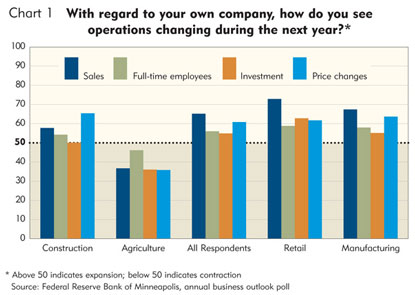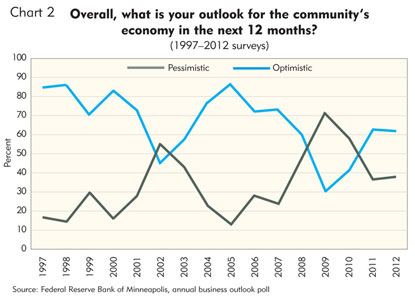Business leaders are optimistic about the future, as they expect sales, employment and capital investment to grow at their firms in the coming year, according to the fedgazette’s annual business conditions poll conducted in November.
The survey’s 409 respondents expect to raise prices but increase wages only moderately and are concerned about government regulation and finding qualified workers. They also reported somewhat improved credit conditions, and they expect modest growth in consumer spending, employment and business investment in their state economies. At the same time, however, business leaders anticipate fewer housing starts this year, as well as higher inflation and sluggish growth at the national level.
Companies looking forward to 2012
Half of the business leaders surveyed expect higher sales at their companies in 2012 (see Chart 1). Respondents from the Minneapolis-St. Paul area are the most optimistic about sales growth, while respondents from the Upper Peninsula of Michigan and Montana are the least optimistic about sales.
Retailers, manufacturers and service providers expect the biggest gains in sales. The increase is due partially to expectations of higher selling prices on their products and services. Forty-four percent of the retail respondents expect to raise prices in 2012, compared with 22 percent who expect to drop prices. Agricultural producers, coming off several good years, expect decreased sales in 2012 due to lower expected commodity prices.
Business leaders also expect to see increased sales volumes by virtue of higher productivity last year—cited by over two-thirds of the respondents—and the expectation of rising employment and capital investment at many companies. Increases in employment are expected at firms across all district states except the U.P. and Montana, where employment estimates are flat. Respondents from all sectors also expect to increase employment, except agricultural producers, who expect to decrease employment. Investment in plant and equipment is expected to increase at firms in Minnesota, North Dakota and western Wisconsin, but decrease in other parts of the district. Retailers, manufacturers and service firms expect to increase capital spending, while firms from other industries expect flat to lower capital expenditures.
Respondents indicated that they may have an easier time financing capital expenditures because access to credit has improved slightly over the past three months. More than one in five respondents indicated that access to bank credit has improved some or improved a lot versus 13 percent who noted deteriorating conditions. This improvement occurred across industry sectors, save for construction, and across district states with the exception of the U.P.
There are some challenges facing district businesses. More than 70 percent of the respondents said that complying with government regulation was a challenge or serious challenge. In addition, 41 percent said that securing workers was a challenge. This concern was widespread across the district, with nearly two-thirds of the respondents from North Dakota and 28 percent from the Minneapolis-St. Paul area reporting difficulty. “It’s very difficult to meet the demand for knowledge workers,” commented a Minnesota-based consulting firm. Several business leaders also commented that the gridlock in Washington and the European debt crisis are adding risk to the 2012 outlook.
Modest state growth, sluggish U.S. growth expected
Overall, leaders are somewhat optimistic about their state economies (see Chart 2). Optimism is strong in the Dakotas, while respondents from Montana and western Wisconsin are somewhat pessimistic (see Chart 3). This optimism/pessimism also flows into the outlook for state economies.
Expectations for local communities generally followed the same pattern. Respondents from Minnesota and the Dakotas were generally positive about employment, business investment and consumer spending. Respondents from Montana, western Wisconsin and the U.P. were generally either neutral or negative. Most industry sectors were positive about their state economies, except agriculture, which was neutral or negative about employment, business investment and consumer spending.
In regard to state economies, most areas of the district expect further decreases in housing starts in 2012 compared with 2011. The only exception is North Dakota, where respondents expect flat housing activity. Respondents from the construction and manufacturing sectors were the most pessimistic. “The housing industry is the worst I have seen in over 40 years,” commented a U.P. construction firm.
Expectations for wage increases are somewhat mixed. Over half foresee increases in their community of 2 percent to 3 percent, and 37 percent expect a 0 percent to 1 percent increase. Respondents in manufacturing and services expect larger wage increases, while the construction and finance, insurance and real estate sectors expect the lowest increases in wages in their communities.
Respondents are concerned about national economic conditions. One in eight expects a recession next year, and 72 percent expect GDP growth of 1 percent to 2 percent. “I am concerned about the stagnant condition of the national economy and that it will continue into 2012,” commented a Minnesota financial firm. Inflation is also a concern, as 30 percent expect CPI to increase by 4 percent or more. “Costs still trending up,” commented a Minnesota manufacturer.
Business Poll Results [xls]








